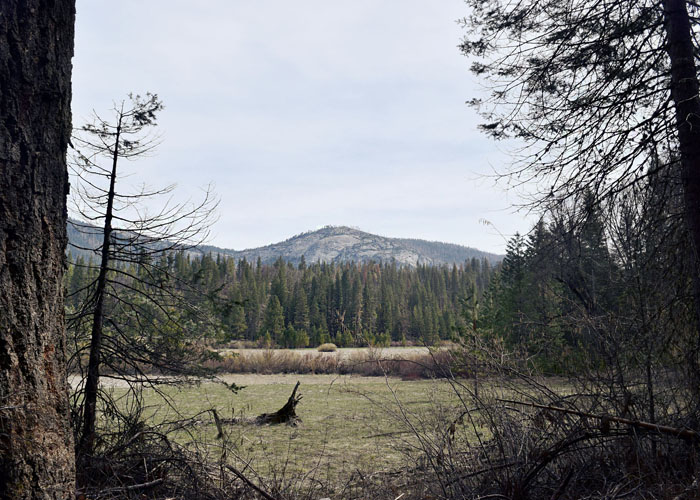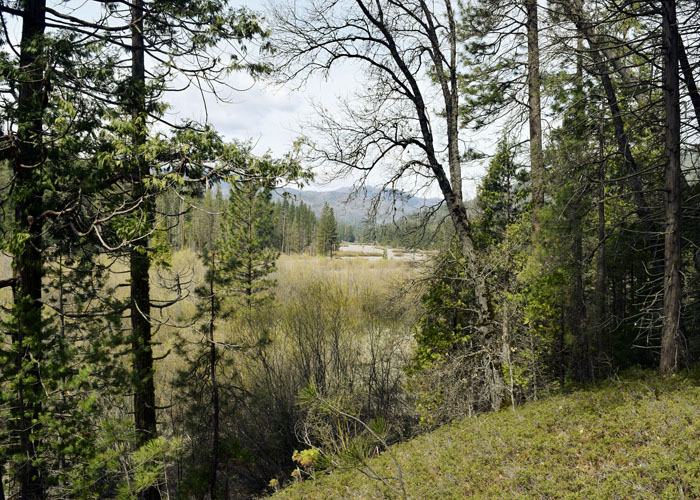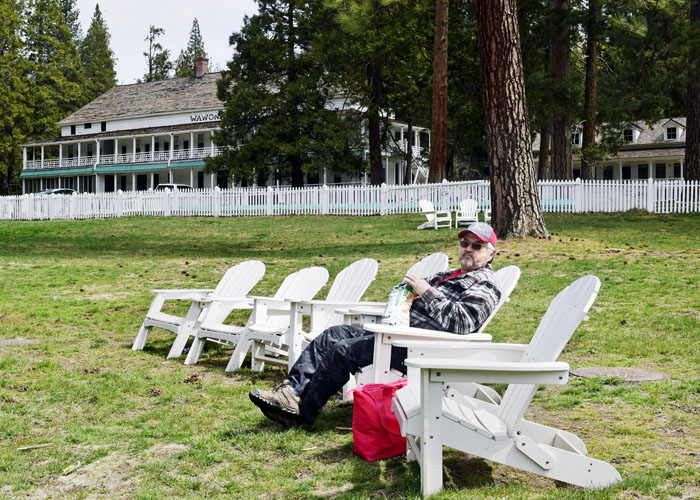March 31, 2022
Wawona Meadow Loop, Yosemite National Park
Total distance walked: 3.6 miles
On a crisp spring morning, Chris and I drove to Wawona in Yosemite National Park to hike the Wawona Meadow Loop. Across the street from the Wawona Hotel lies Chowchilla Mountain Road—a 14-mile (still functional) former stagecoach road into Yosemite from Mariposa. To reach the trailhead, we walked along the footsteps of pioneers who first made their way into Yosemite via this route. We left the stagecoach road and turned southeast into a pine and cedar forest to begin the loop hike.

We walked along an old, disintegrating asphalt trail that circles the perimeter of Wawona Meadow and offers views of the historic Wawona Hotel.

Workaholic Frederick Law Olmsted (1822-1903), designer of New York City’s Central Park, was residing in Mariposa County in 1864. That summer, the vexing heat of the foothills and the severe California drought led him to make a change. He, his wife and four children, the children’s governess, a cook/guide/groom, and two friends left town for a seven-week camping trip. With everyone and everything loaded onto a twenty-one horse and mule team, they headed to Wawona.

The group likely entered Wawona via Chowchilla Mountain Road, the road we first walked. The Olmsted party set up a base camp of four tents in a meadow near Clark’s Station (currently the Wawona Hotel).

Could their base camp have been in the meadow that Chris and I were circumnavigating?

As we ambled through the forest, we caught glimpses of the meadow through the trees. Throughout the years, it has seen numerous changes. It was once a landing strip for early airplanes. It was also a fruit and vegetable garden for Clark’s Station—named for Galen Clark, pioneer and founder of the Wawona Hotel; as well as a place to graze horses, cows, and pigs. If the Olmsted family didn’t camp in this meadow, maybe they grazed their horses there.

Historic split-rail fencing, and cattle chutes can be seen around the edge of the meadow.

Wildflowers bloom in the meadow and showy swallowtail butterflies may be seen fluttering, but we were too early in the year to see either. Under the shade of the trees, a bright red caught my eye. Snow plants! John Muir called them, “red, fleshy, and watery and looks like a gigantic asparagus shoot.”

Meadows are supported by water that slowly moves over them. There was standing water and mud across the trail that we carefully maneuvered through. In 1936, ditches were dug around the meadow to drain it, drying it out and changing its ecosystem.

In 2010, the National Park Service began its restoration.

The Olmsted party spent two weeks near Clark’s Station (Wawona Hotel). Then Frederick entered Yosemite Valley where he set up a permanent camp somewhere opposite Yosemite Falls. In 1865, he was appointed Chairman to the first Board of Commissioners for managing the newly established Yosemite Valley and Mariposa Grove land grants.

Olmsted recognized the “pristine natural landscapes” of Yosemite. He said it provides people with “refreshing rest and reinvigoration.” Enjoying the sunshine, Chris and I ended our hike on the grass of the Wawona Hotel steeped in Yosemite’s beauty and history.

Happy Birthday Frederick! Olmstead was born 200 years ago on April 26, 1822
LikeLiked by 1 person
You are so knowledgeable and offer us a treasure trove of information about the hikes you do. Thank you!
LikeLiked by 1 person
Thank you, Cari. It was timing. I recently read the story of Olmsted.
LikeLike
Thanks for the interesting history lesson, Janet, and the beautiful photos.
LikeLiked by 1 person
Thank you, Carol. 🙂 Hope you are well.
LikeLike
What a lovely day for a hike. Especially love the photo of the red buds. Something beautiful and alive in the middle of dead branches, leaves and needles. Thank you for taking us along and I love the history too.
LikeLiked by 1 person
Thanks, Terri. The snow plants were a surprise. I always love to find them in the forest. I don’t remember seeing any last year. Glad they were there this year.
LikeLike
I’ve never seen snow plants before, they look so pretty. Looks like you had wonderful weather for a spring hike.
LikeLiked by 1 person
Fantastic!
LikeLiked by 1 person
Thanks, Peggy.
LikeLike
Wonderful! Well shared thanks 😊👍
LikeLiked by 1 person
Thank you.
LikeLike
Wonderful well shared thanks 😊👍
LikeLiked by 1 person
Thank you!
LikeLike
Amezing well shared thanks 😊👍
LikeLiked by 1 person
Thank you, and thank you for the comment.
LikeLike
Great photos and story!!
LikeLiked by 1 person
Thank you. 🙂
LikeLike